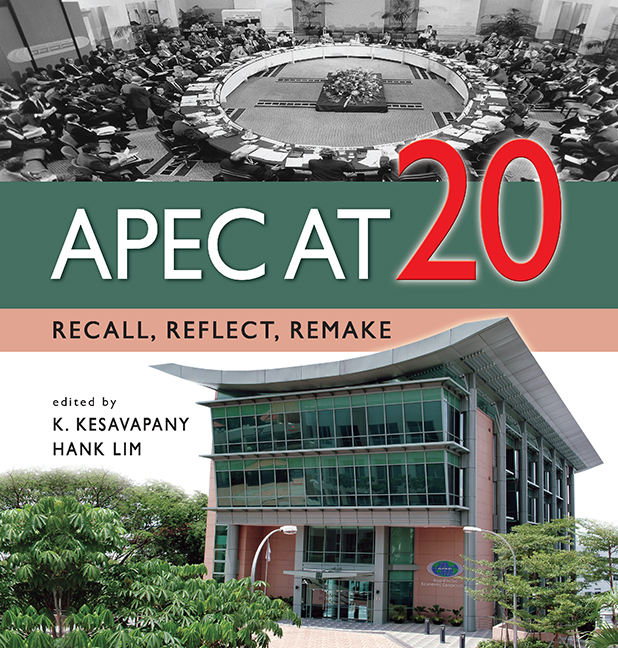Book contents
- Frontmatter
- Frontispiece
- contents
- Foreword by Ambassador Michael Tay
- Preface
- About the Authors
- Asia-Pacific Economic Cooperation (APEC)
- CHAPTER 1 APEC: Genesis and Challenges
- CHAPTER 2 APEC's Origins and its Future
- CHAPTER 3 Four Adjectives Become a Noun: APEC The Future of Asia-Pacific Cooperation
- CHAPTER 4 APEC's Eye on the Prize: Participants, Modality, and Confidence-Building
- CHAPTER 5 APEC: Taking Stock and Looking Ahead
- CHAPTER 6 Revamping APEC's Concerted Unilateral Liberalization
- CHAPTER 7 APEC at 20: Assessment of Trade/Investment Liberalization, Facilitation and Ecotech Activities
- CHAPTER 8 Integrating the Business Community in the APEC Process: Genesis of the Pacific Business Forum
- APPENDICES
- Index
CHAPTER 3 - Four Adjectives Become a Noun: APEC The Future of Asia-Pacific Cooperation
from Asia-Pacific Economic Cooperation (APEC)
Published online by Cambridge University Press: 21 October 2015
- Frontmatter
- Frontispiece
- contents
- Foreword by Ambassador Michael Tay
- Preface
- About the Authors
- Asia-Pacific Economic Cooperation (APEC)
- CHAPTER 1 APEC: Genesis and Challenges
- CHAPTER 2 APEC's Origins and its Future
- CHAPTER 3 Four Adjectives Become a Noun: APEC The Future of Asia-Pacific Cooperation
- CHAPTER 4 APEC's Eye on the Prize: Participants, Modality, and Confidence-Building
- CHAPTER 5 APEC: Taking Stock and Looking Ahead
- CHAPTER 6 Revamping APEC's Concerted Unilateral Liberalization
- CHAPTER 7 APEC at 20: Assessment of Trade/Investment Liberalization, Facilitation and Ecotech Activities
- CHAPTER 8 Integrating the Business Community in the APEC Process: Genesis of the Pacific Business Forum
- APPENDICES
- Index
Summary
The annual APEC Leaders Meeting, one of the largest regular gatherings of heads of state in the world, is frequently criticized in the media, which find it high on expense, ritual, and protocol, but low on concrete achievements. For example, The Economist, following the 2007 Sydney meeting, wrote a scathing assessment describing APEC as a stale joke: “It is not just that APEC has no obvious function. It is worse than that: it actually has a pernicious effect. Its very existence creates the illusion that something is being done, and so weakens other efforts to reach meaningful agreements on, for example, climate change and trade.” Other more dispassionate assessments of APEC, particularly in its second decade, have also been sceptical. Writing shortly after the association's tenth anniversary, John Ravenhill found APEC “adrift”. Allan Gyngell and Malcolm Cook contended in 2005 that APEC was “balanced on the brink of terminal irrelevance”. More recently, the Pacific Economic Cooperation Council's annual surveys of regional business, government, and academic élites found that even these adherents of Asia-Pacific cooperation demonstrate considerable dissatisfaction with the performance of Asia-Pacific regional institutions, including APEC.
If achieving concrete, near-term policy outcomes should be the measure of APEC's success, the institution would surely come up far short. But this misses the main point. For those who foresaw that the Asia-Pacific region was rapidly replacing the trans-Atlantic region as the core area of global growth and governance, APEC was and remains an essential institution, bringing the leading economies on both sides of the Pacific together in a common forum and cooperative, on-going process. It is the most significant multilateral connection across the Pacific, and its very existence softens the impact of (and thus helps to flourish) the more geographically restricted regionalisms in both East Asia and the Americas.
Multinational and intergovernmental institutions — from the United Nations to the smallest organization — begin with dreams, but are established through compromises among the sovereign states that create them. In APEC's case, there was opposition in the initial meeting in 1989 to anything that would suggest an on-going organization.
- Type
- Chapter
- Information
- APEC at 20Recall, Reflect, Remake, pp. 29 - 40Publisher: ISEAS–Yusof Ishak InstitutePrint publication year: 2009

